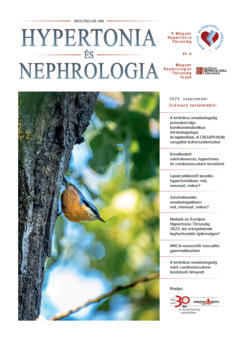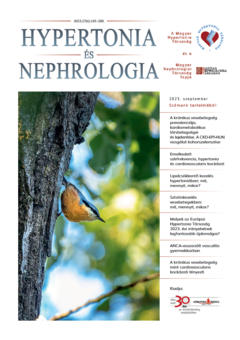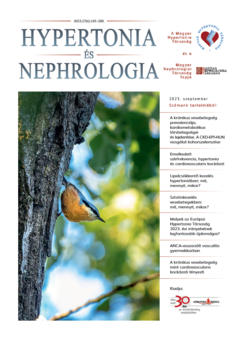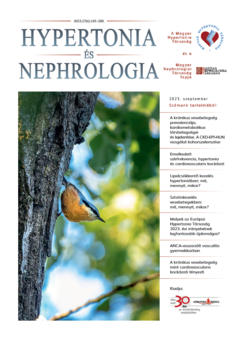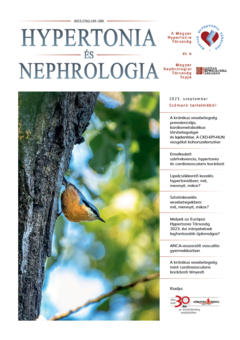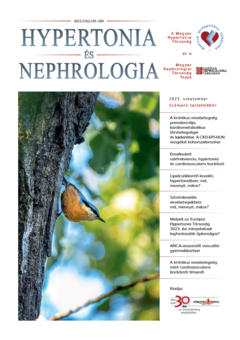The eLitMed.hu medical portal uses computer cookies for convenient operation. Detailed information can be found in the Cookie-policy.
Hypertension and nephrology - 2023;27(04)
Content
[Prevalence, Cardiometabolic Comorbidities and Reporting of Chronic Kidney Disease; A Hungarian Cohort Analysis]
[Célkitűzés: A krónikus vesebetegség (CKD) megnövekedett komorbiditási teherrel, rokkantsággal és halálozással társul, így világszerte jelentős népegészségügyi problémát jelent. Magyarországon azonban nem rendelkezünk prevalenciaadatokkal. Módszerek: Vizsgálatunkban a CKD prevalenciáját, stádiummegoszlását és a gyakori társbetegségeket határoztuk meg Magyarországon, a Pécsi Tudományegyetem vonzáskörzetében, Baranya vármegyében élő, egészségügyi szolgáltatást igénybe vevő egyének csoportjában, 2011 és 2019 között, a becsült glomerularis filtrációs ráta (bGFR), az albuminuria és a nemzetközi betegségkódok alapján, adatbázis-elemzés segítségével. Összehasonlítottuk a laboratóriumi mérésekkel igazolt és a releváns diagnóziskódokkal regisztrált CKD-betegek számát. Eredmények: A régióban elő 296 781 egyén közül 31,3%-nál történt bGFR-mérés és 6,4%-nál végeztek albuminuriameghatározást, akik között 13 596 CKD-beteget (14,0%) azonosítottunk a laboratóriumi határértékek alapján. Meghatároztuk a bGFR szerinti stádiummegoszlást (G3a: 70%, G3b: 22%, G4: 6%, G5: 2%). Az összes CKD-beteg 70,2%-a volt hypertoniás, 41,5%-a volt diabeteses, 20,5%-ánál fordult elő szívelégtelenség, 9,4%-ánál szívinfarktus és 10,5%-ánál stroke. A laboratóriumilag igazolt esetek csupán 28,6%-ánál történt meg a CKD diagnózis kódolása a 2011–2019 közötti időszakban. Következtetések: A CKD prevalenciája 14,0% volt az egészségügyi szolgáltatást igénybe vevő lakosok magyarországi szubpopulációjában a 2011–2019 közötti időszakban, emellett a CKD diagnózisának dokumentálását jelentősen alacsonyabbnak találtuk.]
[Elevated heart rate, hypertension and cardiovascular risk]
[The activity of the autonomic (parasympathetic and sympathetic) nervous system plays a decisive role in the regulation of the circulatory system and in the adaptation of the organism to the ever-changing environmental situation. The equilibrium state of the parasympathetic and sympathetic nervous systems (or its cessation in the case of autonomic dysfunction) determines the heart rate and contractility of the heart muscle. The sympathetic nervous system also plays a decisive role in determining the degree of peripheral vascular resistance. These factors are basic elements for regulating blood pressure. Based on extensive research conducted over the past five decades, the significance of elevated heart rate can be outlined for today’s practicing physicians, especially when assessing cardiovascular risk in hypertensive patients. This brief summary was intended to collect the most important literature data in this regard.]
[Lipid-lowering therapy in hypertension: what, how much and when?]
[Hypertension and dyslipidemia are two main risk factors for cardiovascular diseases. Hyperlipidemia and hypertension co-exist in a large proportion of patients. Furthermore, people dealing with hyperlipidemia and hypertension are at a higher risk of developing cardiovascular diseases than those who suffer from hyperlipidemia or hypertension. Therefore, an essential aspect of hypertension therapy is the management of hyperlipidemia as it can prevent the progression of atherosclerosis and related macrovascular events such as myocardial infarction and stroke. Previous studies have demonstrated that 3-hydroxy-3-methylglutaryl coenzyme A reductase inhibitor statins were associated with an unexpected reduction in blood pressure in hypertensive patients. Fibrates and omega-3 fatty acids may also improve the efficacy of antihypertensive treatment. These pharmacological approaches have a favorable effect on both lipids and blood pressure thresholds. These treatments hold great promise in preventing cardiovascular complications in this unique population.]
[Statin therapy in kidney patients: what, how much and when?]
[The association between an elevated cholesterol value and the risk of cardiovascular disease is well known. Over decades various classes of drugs were introduced to decrease cholesterol levels, but the real breakthrough came with the use of statins. In the population without renal disease numerous studies have proven statins to be effective in decreasing the level of lipids, in reducing cardiovascular risk, in delaying atherosclerosis and in the regression of plaque. Similarly, in the population with renal disease, many studies have justified the role of statins in reducing CV risk, especially in mild-moderate renal failure, but also in the population of patients requiring dialysis. Studies have also proven their effectiveness in slowing the progression of renal failure and in the reduction of proteinuria. They might also play a protecting role in contrast material-, aminogylcoside-, cardiac- surgery-induced acute kidney injury. Both the cardiac and the renoprotective effectiveness can be explained by summary of their lipid-decreasing and pleiotrop effects. Based on the increased CV risk proven in the population with renal disease, chronic kidney disease is in the high and very-high risk group in national and international guidelines. Reaching the determined lower target values in the high risk and very high risk group is only possible via aggressive antilipemic treatment. Out of statins, molecules capable of intensive decreasing of lipid levels are in favor, in case of ineffectiveness or even from start ezetimib (an agent inhibiting cholesterine uptake) can be added.]
Hypertension and nephrology
SEPTEMBER 13, 2023
[Melyek az Európai Hypertonia Társaság 2023. évi irányelvének legfontosabb újdonságai?]
[Húsz évvel az Alberto Zanchetti vezetésével összeállított és a nemzetközi tudományos életben rendkívüli mértékben elismert, az orvosi területen mindmáig a legtöbbet idézett első európai hypertonia-irányelv publikálását követően, az Európai Hypertonia Társaság (European Society of Hypertension – ESH) 2023. évi kongresszusán, Milánóban mutatták be a társaság új, a hypertonia ellátását segítő vezérfonalát. Az irányelv a kongresszussal egy időben került online publikálásra (1), a végleges publikáció jelen összefoglaló megjelenésekor, reményeink szerint, már olvasható a Journal of Hypertension augusztusi számában. Ez az irányelv a korábbi kettő kiadástól eltérően, amikor is az Európai Kardiológus Társasággal (European Society of Cardiology – ESC) közösen került kiadásra, az ESH egyedüli gondozásában jelent meg. ]
[ANCA associated vasculitis in childhood]
[ANCA-associated vasculitis is a systemic autoimmune disease with a severe course and a high percentage of renal involvement. It is much more common in the adult population than in children, so there are few large case-control studies in pediatric population. We present case reports of six children treated for ANCA-associated vasculitis over the past five years. In addition to the case presentation, we will also discuss current immunosuppressive therapeutic options and the issue of plasmapheresis. We describe the initial symptoms and the time between the onset of symptoms and diagnosis. We present the initial laboratory data and a 12-month retrospective follow-up of renal function. We also describe the therapies used in our patients. Given the small number of cases, we do not aim to present detailed statistical conclusions.]
[Chronic kidney disease as cardiovascular risk factor]
[Chronic kidney disease (CKD) is one of the major risk factors for cardiovascular disease (CVD). More than 50% of patients with CKD die from CVD before starting dialysis. The relationship between CKD and CVD is explained by several mechanisms, including arterial stiffness, inflammation, oxidative stress, anaemia, calcium-phosphorus metabolism disorder and renin-angiotensin-aldosterone system activation. In order to reduce the cardiovascular risk of patients with CKD, it is important to recognize and treat CKD early, as well as to optimize the traditional and non-traditional risk factors. The aim of this review is to summarize the associations between CKD and CVDs, as well as the prevention and treatment options.]
[Beszámoló az Európai Hypertonia Társaság XXXII. kongresszusáról]
[2023. június 23–26. között Milánóban rendezték meg az Európai Hypertonia Társaság (European Society of Hypertension – ESH) XXXII. kongresszusát. A kongresszusra 958 absztraktot küldtek be, közülük nyolc Magyarországról származott. A kongresszus első napján, pénteken kora délután elsősorban az ESH különböző munkacsoportjai kaptak főtéma-lehetőséget, illetve a munkacsoportok közgyűléseire is ekkor került sor. Jómagam az ESH Working Group of Large Arteries-ének tagjaként ezen a szekción vettem részt, ahol szóba került az artériás érfalmerevség mérésének klinikai használatáról szóló, az év végéig tervezetten megjelenő konszenzusdokumentumának a helyzete. Ez az irányelv sokat segíthet a klinikusok számára a területet jelenleg övező számos bizonytalanság tisztázásában. Egy másik, a közeljövőben megjelenő közlemény a területhez köthető számos mérőeszköz validálásához is aktualizált iránymutatást fog nyújtani...]
1.
Clinical Neuroscience
Is there any difference in mortality rates of atrial fibrillation detected before or after ischemic stroke?2.
Clinical Neuroscience
Factors influencing the level of stigma in Parkinson’s disease in western Turkey3.
Clinical Neuroscience
Neuropathic pain and mood disorders in earthquake survivors with peripheral nerve injuries4.
Journal of Nursing Theory and Practice
[Correlations of Sarcopenia, Frailty, Falls and Social Isolation – A Literature Review in the Light of Swedish Statistics]5.
Clinical Neuroscience
[Comparison of pain intensity measurements among patients with low-back pain]1.
Clinical Neuroscience Proceedings
[A Magyar Stroke Társaság XVIII. Kongresszusa és a Magyar Neuroszonológiai Társaság XV. Konferenciája. Absztraktfüzet]2.
3.
Journal of Nursing Theory and Practice
[A selection of the entries submitted to the literary contest "Honorable mission: the joys and challenges of our profession" ]4.
Journal of Nursing Theory and Practice
[End of Life and Palliative Care of Newborns in the Nursing Context]5.
Journal of Nursing Theory and Practice
[Aspects of Occupational Health Nursing for Incurable Patients ]